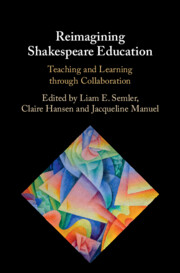Book contents
- Reimagining Shakespeare Education
- Reimagining Shakespeare Education
- Copyright page
- Dedication
- Contents
- Figures
- Tables
- Notes on Contributors
- Acknowledgements
- Introduction
- Part I Reimagining Shakespeare with/in Schools
- Part II Reimagining Shakespeare with/in Universities
- Part III Public Reimaginings
- Introduction
- Chapter 9 Hecate
- Chapter 10 ‘I’ll Teach you Differences’
- Chapter 11 The Pop-up Globe
- Chapter 12 The Place of Shakespeare North
- Part IV Digital Reimaginings
- Part V Reimagining Performance
- Afterword
- Index
- References
Chapter 11 - The Pop-up Globe
Designing and Learning to Play an ‘Empathy Drum’
from Part III - Public Reimaginings
Published online by Cambridge University Press: 02 February 2023
- Reimagining Shakespeare Education
- Reimagining Shakespeare Education
- Copyright page
- Dedication
- Contents
- Figures
- Tables
- Notes on Contributors
- Acknowledgements
- Introduction
- Part I Reimagining Shakespeare with/in Schools
- Part II Reimagining Shakespeare with/in Universities
- Part III Public Reimaginings
- Introduction
- Chapter 9 Hecate
- Chapter 10 ‘I’ll Teach you Differences’
- Chapter 11 The Pop-up Globe
- Chapter 12 The Place of Shakespeare North
- Part IV Digital Reimaginings
- Part V Reimagining Performance
- Afterword
- Index
- References
Summary
The Pop-up Globe took as its starting point ground-breaking research into the second Globe playhouse, and its size and configuration reflect the geometry theorised in that research. Its design maps onto the archaeology of the first and second Globes much more accurately than does Shakespeare’s Globe in London, and its reproduction of the geometry of the original Globes results in an actor–audience relationship that is markedly more intense and intimate. It has delivered seven critically acclaimed and successful seasons (Auckland 2016, 2017, 2017/18, 2018/19; Melbourne 2017/18; Sydney 2018; Perth 2019) that have created a whole new audience for Shakespeare in repertory, often with transformative educational effects.
But it is a scaffolding building, not timber framed as is the London Globe; the features of its stage and scenae frons and the staging practices employed in its productions have developed from one iteration to the next, referencing historical practices and staging theories but overtly prioritising modern production imperatives. So, what is it that constitutes its historical authenticity?
The authors of this chapter are the principal academic and theatre maker involved in this collaboration, and they reflect on the relationships between a pure historical research project into the architecture of the second Globe playhouse and its application in the Pop-up Globe, on the effects of that architecture on its audience, and on the issues and creative tensions that flow from two radically different but inter-dependent projects.
Keywords
- Type
- Chapter
- Information
- Reimagining Shakespeare EducationTeaching and Learning through Collaboration, pp. 174 - 187Publisher: Cambridge University PressPrint publication year: 2023



